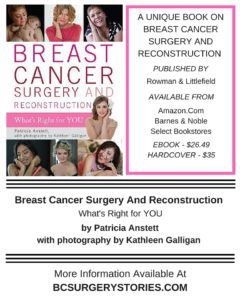The best way you can help educate others about breast cancer surgery and reconstruction issues is to ask your public library to carry “Breast Cancer Surgery and Reconstruction: What’s Right for You” (Rowman & Littlefield; 2016) Here’s a flyer to take with you, and a few reviews.
LIBRARY JOURNAL REVIEW:: This work by journalist Anstett and photographer and breast cancer survivor Galligan (she’s featured here in Chapter 4) highlights the options and advances made in breast cancer treatment for those facing the disease, with women sharing their experiences, in detail, in order to provide the most up-to-date information. Decision-making can focus on mastectomy over lumpectomy with radiation, contralateral prophylactic surgeries, reconstruction (a variety on the menu, including a Texas-based surgeon who performs robotically enhanced minimally invasive reconstruction), or none at all. Genetic testing is a driver of some procedures, and the efficacy of those choices is covered as well. Additional chapters address insurance, sexuality, and family responsibilities. The text overall is accessible, but ultimately the authors suggest women take the time to deliberate on the alternatives and resist pressure from the medical community to jump in without knowing all the therapies and their repercussions. VERDICT A straightforward addition to the breast cancer canon.(Library Journal)
Book List Review: In 2014, more than 230,000 women were diagnosed with breast cancer. More than 102,000 of them underwent reconstruction, more than 71,000 right away and nearly 31,000 later. Anstett, a veteran newspaper reporter, and Galligan, an Emmy-winning photographer and breast-cancer survivor, spent two years thoroughly investigating women’s choices: breast-sparing lumpectomies with radiation; removal of one breast with and without reconstruction; removal of two breasts with and without reconstruction; reconstruction with tissue, saline implants, and silicone implants; nipple-sparing operations; nipple tattoos; and preventive mastectomies. Fortunately, they ably spell out the pros and cons of each option, and they provide the full names of the survivors along with their photographs. Anstett and Galligan also include chapters on finances and insurance, sex and intimacy, and how to cope with feeling like ‘damaged goods’ after surgery. Shaded boxes provide invaluable additional information, including a Q&A with a genetics counselor and lists of resources, such as the American Society of Plastic Surgeons. This important, well-reported guide should empower women with breast cancer to figure out their own best treatment. (Booklist)

